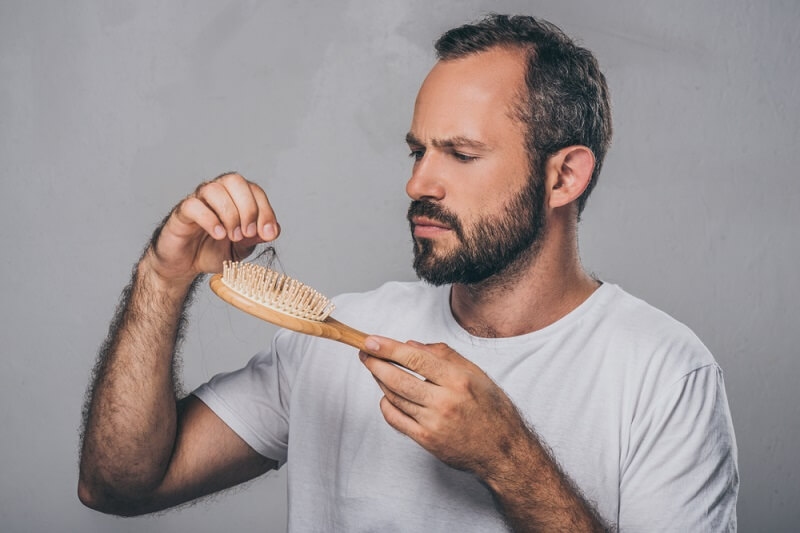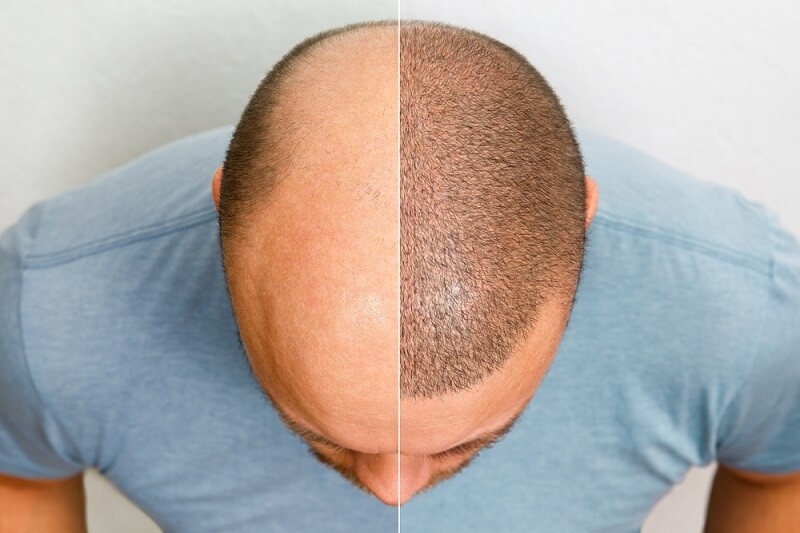Understanding Hair Loss in Men: Causes and Solutions

Hair loss in men is an emotionally distressing issue that can significantly impact self-esteem and overall lifestyle choices. Among the numerous causes of hair loss in men, male pattern baldness is a prominently known effect. It has been learned over these years how pattern baldness works; people must be aware of these details. It is time to explore the intricate conditions of hair loss in men and their wide-reaching effects. If you're trying to comprehend what causes hair loss in men, you've come to the right place.
What is Male Pattern Baldness?

Hair loss in men, specifically male pattern baldness, is a unique form known by society for its highly predictable pattern. Primarily beginning with a receding hairline, the hair at the temples begins to thin and deteriorate, forming an unmistakable "M" shape. Following up next is the crown of the head, which experiences thinning, resulting in an evident bald spot. Hair loss is an eventually progressing condition that can be observed to increase, resulting in patchiness across the head.
Ultimately, these areas merge and conclusively create a distinctive "horseshoe" pattern of hair that primarily resides on the sides and back of the head. Male pattern baldness is the most prevalent contributor to hair loss in men, with some individuals experiencing its onset as early as their late teens or early twenties. It is not recommended for early adult men to make rash decisions if they struggle with hair loss. First, you should get your checkups done with specialists who can guide you further.
What Causes Male Pattern Baldness?
The leading cause of male pattern baldness is genetics, mainly found easily in men due to the lesser hair volume. If your father or grandfather experienced it, you are also at an elevated risk of developing it. A set of specific genes inherited from your family dominate the sensitivity of your hair follicles to a hormone known as dihydrotestosterone (DHT). Since the relativity of this hormone is derived from testosterone, it controls the development of male characteristics. However, it is known to harm the effects on hair follicles in specific individuals. DHT gradually shrinks hair follicles, causing the hair they produce to become progressively thinner and shorter. Eventually, these shrunken follicles lose their ability to grow hair, ending in baldness.
Who Does Male Pattern Baldness Affect?
The impact of male pattern baldness is not restrictive to being an inherited problem. It affects not only those with a familial history of the condition but also individuals with no such genetic lineage. You have a higher risk if you possess both the genetic predisposition and the hormonal milieu that encourages hair loss in men. Hair loss in men is also focused on ethnicity or geography, which makes it a universal concern for men across the globe. These attributes have also been known to affect the mental health of men, as well as the effects of anxiety and stress.
What Are the Symptoms of Male Pattern Baldness?

Recognizing the early symptoms of male pattern baldness is essential and advantageous for addressing the issue proactively. These symptoms typically encompass:
Receding Hairline
The initial manifestation is the gradual recession of the hairline, primarily at the temples, creating a distinctive "M" shape. This is the beginning of the condition that presents itself with less intervention to your hair growth but is prominent enough to be spotted.
Thinning at the Crown
Hair in the crown area progressively thins, often forming a noticeable bald patch. You may not notice the patch incase you have longer hair, but it is better to keep checking yourself.
Progressive Hair Loss
Over time, the receding hairline and crown baldness frequently merge, leaving a residual "rim" of hair primarily around the sides and back. This condition elucidates the criticality of the progression, which demands immediate acting on the treatments.
Miniaturization
Affected hair follicles undergo a process known as miniaturization, leading them to produce finer, shorter hair, contributing to an overall reduction in hair density.
What Are the Most Effective Treatments?

Fortunately, many effective treatments in hair loss have been formulated for men, mainly catering to male pattern baldness. Lifestyle choices can also be contributing with plans like following a balanced diet or following regimens for hair care. These treatments aim to curtail the advancement of hair loss while concurrently stimulating the regrowth of new, healthier hair. Some of the most widely recognized treatments include:
Minoxidil
Available without a prescription in liquid or foam formulations, minoxidil is applied directly to the scalp. This medication enhances blood flow to hair follicles, potentially reactivating dormant follicles and promoting the development of thicker, more robust hair.
Finasteride
A prescription medication, finasteride, combats the cause of hair loss in men by inhibiting the enzymatic conversion of testosterone into DHT. Reducing DHT levels within the scalp can slow down or even reverse hair loss for many users.
Hair Transplantation
Surgical procedures such as follicular unit transplantation (FUT) or follicular unit extraction (FUE) involve the removal of healthy hair follicles from donor areas and their strategic transplantation to areas experiencing baldness. This provides a more permanent and natural-looking solution for hair restoration.
Laser Therapy
Low-level laser therapy (LLLT) devices, available in various forms such as helmets or combs, stimulate hair follicles and have shown promise in promoting hair growth.
All Types of Medications for Male Pattern Baldness
In addition to minoxidil and finasteride, several other medications can be considered to address hair loss in men resulting from male pattern baldness:
Dutasteride
This prescription medication functions similarly to finasteride, inhibiting DHT production, and is sometimes prescribed for more severe causes of hair loss in men.
Ketoconazole
An antifungal shampoo, ketoconazole, effectively reduces DHT levels on the scalp when used consistently. This catalyzes the restriction of causes of hair loss in men.
Spironolactone
Although typically prescribed off-label for women with female pattern baldness, some men also consider spironolactone as it can block the effects of DHT on hair follicles.
Conclusion
Hair loss in men, notably due to male pattern baldness, is a concern with numerous contributing factors and a wide array of potential solutions. There is a dire need to understand what causes hair loss in men, recognize the symptoms in their early stages, and take proactive measures. Taking care of your hair loss condition could also help you better with your emotional wellbeing and mental health. Whether you opt for topical treatments, medications, or surgical interventions, seeking guidance from a healthcare professional or dermatologist is crucial for determining the most suitable approach suited to your circumstances. You can regain confidence and enjoy a fuller head of hair by taking action.
This content was created by AI
-1717753922-r.jpg)